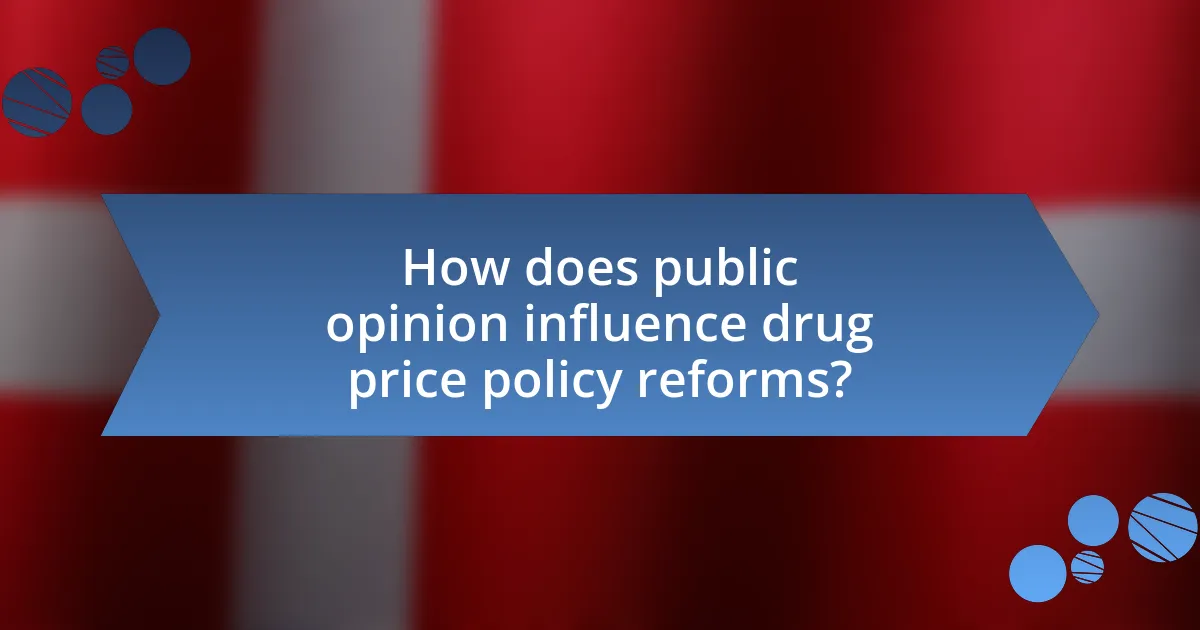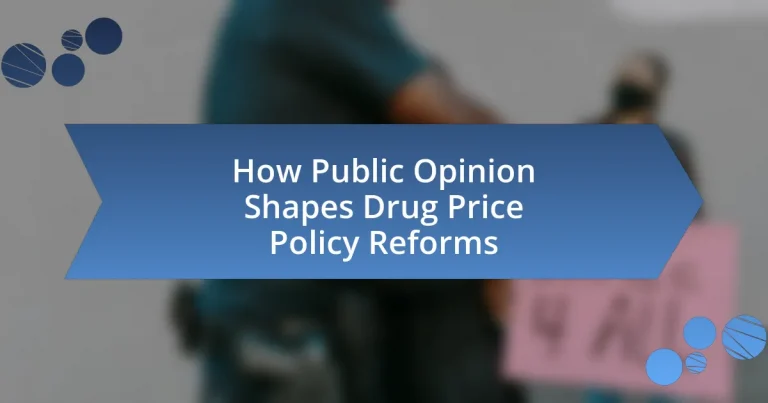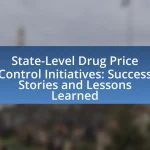The article examines how public opinion significantly influences drug price policy reforms, highlighting the relationship between collective sentiment and legislative action. It discusses the role of public perception in shaping drug pricing policies, the factors that contribute to public attitudes, and the mechanisms through which public opinion can drive policy changes. Additionally, the article explores the impact of advocacy groups, media, and social platforms on public awareness and legislative discussions, while addressing challenges such as misinformation and political interests that complicate alignment between public sentiment and industry practices. Ultimately, it emphasizes the importance of public engagement in advocating for affordable medications and effective policy reforms.

How does public opinion influence drug price policy reforms?
Public opinion significantly influences drug price policy reforms by shaping the political agenda and prompting legislative action. When a substantial portion of the population expresses dissatisfaction with high drug prices, policymakers often respond to this sentiment to secure votes and maintain public support. For instance, surveys indicate that over 80% of Americans believe that prescription drug prices are too high, which has led to increased calls for reforms such as price negotiations and transparency measures. Additionally, advocacy groups leverage public opinion to lobby for changes, highlighting the urgency of the issue and pressuring legislators to act. This dynamic illustrates how collective public sentiment can drive policy changes aimed at making medications more affordable.
What role does public perception play in shaping drug pricing policies?
Public perception significantly influences drug pricing policies by driving political and regulatory responses to public concerns about affordability and access. When the public expresses dissatisfaction with high drug prices, it prompts lawmakers to consider reforms aimed at increasing transparency and regulating prices. For instance, surveys indicate that a majority of Americans support government intervention to lower prescription drug costs, which has led to legislative proposals such as the Inflation Reduction Act of 2022, allowing Medicare to negotiate prices for certain drugs. This demonstrates that public sentiment can catalyze policy changes, as elected officials often respond to constituents’ demands to maintain their support and address societal issues.
How do public attitudes towards drug affordability impact legislative actions?
Public attitudes towards drug affordability significantly influence legislative actions by creating pressure on lawmakers to address the issue. When a substantial portion of the population expresses concern over high drug prices, legislators often respond by proposing or supporting policies aimed at reducing costs, such as price caps or increased transparency in drug pricing. For instance, surveys have shown that over 70% of Americans believe that the government should negotiate drug prices, prompting legislative initiatives like the Inflation Reduction Act of 2022, which allows Medicare to negotiate prices for certain medications. This correlation between public sentiment and legislative response underscores the power of collective opinion in shaping drug price policy reforms.
What factors contribute to public opinion on drug prices?
Public opinion on drug prices is influenced by several key factors, including personal experiences with healthcare costs, media coverage, and political discourse. Personal experiences, such as high out-of-pocket expenses for medications, can lead individuals to develop negative perceptions of drug pricing. Media coverage plays a significant role by highlighting stories of patients struggling to afford medications, which can amplify public concern and awareness. Additionally, political discourse, particularly during election cycles, often focuses on healthcare issues, shaping public sentiment and prompting calls for reform. For instance, surveys indicate that a majority of Americans prioritize lowering drug prices as a critical issue, reflecting the impact of these factors on public opinion.
Why is public opinion important in the context of drug price reforms?
Public opinion is crucial in the context of drug price reforms because it influences policymakers’ decisions and legislative outcomes. When a significant portion of the public expresses concern over high drug prices, elected officials are more likely to prioritize reform initiatives to align with constituents’ demands. For instance, a 2021 survey by the Kaiser Family Foundation found that 88% of Americans support lowering prescription drug prices, demonstrating widespread public backing for reform. This strong public sentiment can lead to increased pressure on lawmakers to implement policies that address affordability, such as price negotiations or caps on drug costs.
How can public support or opposition affect policy outcomes?
Public support or opposition significantly influences policy outcomes by shaping the political landscape and decision-making processes. When a substantial portion of the public expresses support for a specific policy, such as drug price reforms, policymakers are more likely to prioritize and implement those changes to align with voter preferences and secure electoral support. Conversely, strong public opposition can deter lawmakers from pursuing certain policies, as they may fear backlash or loss of support in future elections. For instance, a 2021 survey by the Kaiser Family Foundation found that 88% of Americans support lowering prescription drug prices, indicating that widespread public backing can lead to legislative action. This dynamic illustrates how public sentiment directly impacts the feasibility and direction of policy initiatives.
What historical examples illustrate the impact of public opinion on drug pricing reforms?
Public opinion has significantly influenced drug pricing reforms, as evidenced by the 1990s campaign for affordable HIV/AIDS medications. Activist groups like ACT UP mobilized public sentiment, leading to increased pressure on pharmaceutical companies and the government to lower prices. This resulted in the introduction of the Ryan White Care Act in 1990, which provided funding for HIV/AIDS treatment and emphasized access to affordable medications. Another example is the 2015 public outcry against Turing Pharmaceuticals’ price hike of the life-saving drug Daraprim, which spurred discussions on drug pricing transparency and led to legislative proposals aimed at regulating drug prices. These instances demonstrate how collective public advocacy can drive policy changes in drug pricing.

What mechanisms exist for public opinion to affect drug price policy?
Public opinion can affect drug price policy through mechanisms such as advocacy campaigns, public demonstrations, and social media mobilization. Advocacy campaigns, often led by patient groups or healthcare organizations, can influence policymakers by highlighting the impact of high drug prices on patients’ access to medications. Public demonstrations, such as protests or rallies, can draw media attention and pressure legislators to consider reforms. Additionally, social media platforms enable rapid dissemination of information and mobilization of public sentiment, allowing individuals to voice their concerns and demand action from policymakers. For instance, the rise of hashtags related to drug pricing has led to increased awareness and discussions among the public and lawmakers, ultimately shaping policy debates.
How do advocacy groups mobilize public opinion on drug pricing?
Advocacy groups mobilize public opinion on drug pricing by utilizing strategic communication campaigns that highlight the impact of high drug costs on individuals and families. These groups often employ social media, public demonstrations, and targeted advertisements to raise awareness and generate emotional responses from the public. For instance, campaigns like “Patients Over Profits” have effectively illustrated personal stories of those affected by exorbitant drug prices, fostering empathy and urgency among the audience. Research indicates that when advocacy groups present relatable narratives alongside statistical data, such as the fact that nearly one in four Americans report not filling a prescription due to cost, they significantly enhance public engagement and support for policy reforms aimed at lowering drug prices.
What strategies do these groups use to influence policymakers?
Interest groups employ various strategies to influence policymakers, including lobbying, public campaigns, and coalition-building. Lobbying involves direct interaction with legislators to advocate for specific policies, often supported by data and expert testimony to strengthen their position. Public campaigns leverage media and grassroots mobilization to shape public opinion, creating pressure on policymakers to act in accordance with the group’s agenda. Coalition-building allows these groups to unite with other organizations, amplifying their voice and resources, which can lead to more significant political influence. For instance, the Pharmaceutical Research and Manufacturers of America (PhRMA) has utilized these strategies effectively to advocate against price controls in drug pricing legislation, demonstrating the impact of organized efforts on policy outcomes.
How effective are grassroots campaigns in shaping drug price policies?
Grassroots campaigns are highly effective in shaping drug price policies. These campaigns mobilize public support and raise awareness about the impact of high drug prices, influencing policymakers to consider reforms. For instance, the “Patients Over Pharma” campaign successfully advocated for price transparency and lower costs, leading to legislative proposals in several states. Research indicates that public pressure from grassroots movements can result in significant policy changes, as seen in the 2019 California law aimed at capping insulin prices, which was largely driven by grassroots advocacy.
What role do media and social platforms play in shaping public opinion?
Media and social platforms significantly influence public opinion by disseminating information, framing narratives, and facilitating discussions. They serve as primary sources of news and information, shaping perceptions through selective reporting and editorial choices. For instance, studies show that social media can amplify certain viewpoints, leading to echo chambers where users are exposed primarily to information that reinforces their existing beliefs. This phenomenon can sway public sentiment on critical issues, including drug price policies, as seen in campaigns that mobilize public support or opposition through viral content and targeted messaging. Additionally, platforms like Twitter and Facebook enable real-time engagement, allowing users to express opinions and mobilize collective action, which can directly impact policy discussions and reforms.
How does media coverage influence public perceptions of drug prices?
Media coverage significantly influences public perceptions of drug prices by shaping narratives and highlighting disparities in pricing. When media outlets report on high drug costs, they often emphasize personal stories of individuals affected by these prices, which can evoke emotional responses and raise awareness about the issue. For instance, a study published in the Journal of Health Politics, Policy and Law found that extensive media coverage of drug price hikes led to increased public concern and calls for policy reform. This heightened awareness can pressure policymakers to address drug pricing issues, as public opinion becomes a critical factor in shaping legislative agendas.
What impact do social media campaigns have on drug price policy discussions?
Social media campaigns significantly influence drug price policy discussions by amplifying public awareness and mobilizing grassroots advocacy. These campaigns often highlight the financial burden of high drug prices on consumers, leading to increased pressure on policymakers to address affordability issues. For instance, the #PharmaBro campaign, which targeted Martin Shkreli’s price hikes, garnered widespread media attention and prompted discussions in Congress about drug pricing reforms. Additionally, studies show that social media can shape public opinion, with 70% of users indicating that online discussions affect their views on healthcare policies. This demonstrates that social media serves as a powerful tool for shaping the narrative around drug pricing, ultimately impacting legislative priorities and reforms.

What challenges exist in aligning public opinion with drug price reforms?
Aligning public opinion with drug price reforms faces significant challenges, primarily due to misinformation and varying perceptions of drug pricing. Misinformation can lead to misunderstandings about the actual costs and benefits of reforms, causing public resistance. Additionally, differing socioeconomic backgrounds influence how individuals perceive drug prices and their willingness to support reforms. For instance, a 2021 survey by the Kaiser Family Foundation found that 77% of Americans support lowering prescription drug prices, yet opinions diverge sharply based on political affiliation and personal experiences with healthcare costs. This polarization complicates consensus-building around effective policy changes.
What misconceptions about drug pricing exist among the public?
Many misconceptions about drug pricing exist among the public, including the belief that high prices are solely due to pharmaceutical companies’ greed. This view overlooks the complex factors influencing drug costs, such as research and development expenses, regulatory requirements, and market dynamics. For instance, the average cost to develop a new drug can exceed $2.6 billion, according to a study by the Tufts Center for the Study of Drug Development. Additionally, some people mistakenly think that all drugs are priced uniformly across different countries, ignoring variations in pricing strategies and healthcare systems. These misconceptions can significantly impact public opinion and policy discussions regarding drug pricing reforms.
How do these misconceptions hinder effective policy reform?
Misconceptions about drug pricing and policy reform hinder effective policy reform by creating a distorted understanding of the issues at hand. For instance, the belief that high drug prices are solely due to pharmaceutical companies’ greed overlooks the complexities of research and development costs, regulatory hurdles, and market dynamics. This misunderstanding can lead to public support for simplistic solutions, such as price caps, which may not address the underlying factors contributing to high costs. Consequently, policymakers may feel pressured to implement ineffective reforms that fail to achieve desired outcomes, as evidenced by the limited success of previous price control measures in other countries.
What educational efforts are needed to clarify drug pricing issues?
Educational efforts needed to clarify drug pricing issues include comprehensive public awareness campaigns, targeted educational programs for healthcare professionals, and transparent communication from pharmaceutical companies. Public awareness campaigns can inform consumers about the factors influencing drug prices, such as research and development costs, regulatory processes, and market dynamics. Targeted educational programs for healthcare professionals can enhance their understanding of pricing structures and enable them to better communicate these complexities to patients. Additionally, pharmaceutical companies must adopt transparent communication strategies to disclose pricing rationale and cost breakdowns, fostering trust and understanding among stakeholders. These efforts are essential for demystifying drug pricing and promoting informed public discourse, ultimately influencing policy reforms.
How do political interests complicate public opinion on drug pricing?
Political interests complicate public opinion on drug pricing by influencing perceptions and priorities through lobbying and campaign contributions. For instance, pharmaceutical companies often invest heavily in political campaigns, which can lead to policies that favor their interests over public concerns about high drug prices. According to a 2020 report from the Center for Responsive Politics, the pharmaceutical industry spent over $300 million on lobbying, shaping legislative agendas that may not align with the public’s demand for lower prices. This financial influence can create a disconnect between the public’s desire for affordable medications and the political actions taken, ultimately complicating the formation of a unified public opinion on drug pricing reforms.
What conflicts arise between public sentiment and pharmaceutical industry interests?
Conflicts between public sentiment and pharmaceutical industry interests primarily arise from the disparity between the public’s demand for affordable medications and the industry’s focus on profit maximization. Public opinion often emphasizes the need for lower drug prices and greater access to essential medications, driven by concerns over healthcare affordability and equity. In contrast, the pharmaceutical industry prioritizes revenue generation, which can lead to high pricing strategies for new drugs and treatments. For instance, a 2021 survey by the Kaiser Family Foundation revealed that 77% of Americans believe that prescription drug prices are unreasonable, highlighting a significant gap between public expectations and industry practices. This tension can result in calls for regulatory reforms, such as price controls or increased transparency, which the industry may resist to protect its financial interests.
How can policymakers balance public opinion with industry concerns?
Policymakers can balance public opinion with industry concerns by engaging in transparent dialogue and incorporating stakeholder feedback into the decision-making process. This approach allows policymakers to understand the needs and priorities of both the public and the industry, facilitating compromises that address public health goals while considering economic implications for businesses. For instance, public opinion surveys can reveal strong support for lower drug prices, prompting policymakers to negotiate with pharmaceutical companies to find solutions that maintain innovation while reducing costs. Historical examples, such as the Affordable Care Act, demonstrate that inclusive policymaking can lead to more sustainable reforms that satisfy diverse interests.
What practical steps can individuals take to influence drug price policy reforms?
Individuals can influence drug price policy reforms by actively engaging in advocacy efforts, such as contacting legislators, participating in public forums, and joining or supporting organizations focused on healthcare reform. Engaging with legislators allows individuals to express their concerns about high drug prices and advocate for specific policy changes, such as price negotiations or transparency in pricing. Participating in public forums provides a platform to raise awareness and gather community support, which can amplify the call for reform. Joining organizations like Patients for Affordable Drugs or the American Medical Association can provide resources and collective power to push for legislative changes. Research indicates that grassroots movements and public pressure can significantly impact policy decisions, as seen in the successful campaigns for drug pricing reforms in various states.


